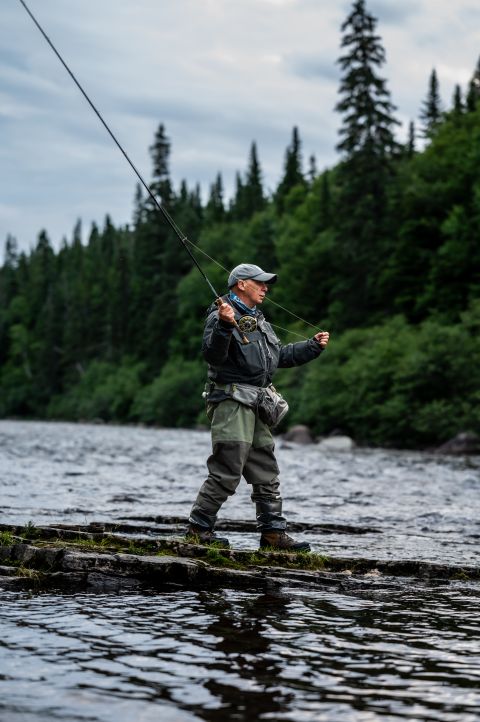
Subscribe & stay up-to-date with ASF

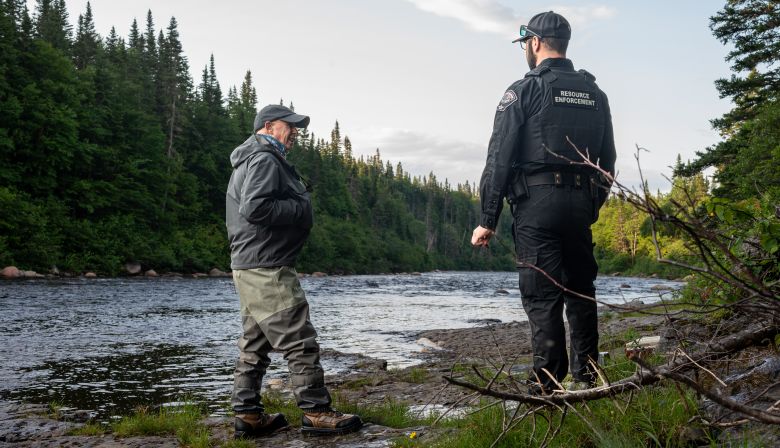
As summer intensifies, our rivers heat up and fish start to seek refuge in cooler pockets. During this time, it’s essential to handle them with utmost care when fishing. Please take a few moments to educate yourself about best fish handling practices and share this link with both novice and experienced anglers alike. Learn more at: https://www.keepfishwet.org/”
—
Traversing the expanse of Newfoundland’s Route 1, heading westward towards Corner Brook, my truck began an erratic dance. There’s a certain charm to unexpected sways, but at 75 mph (100kph) with formidable logging trucks charging from the opposite direction, it’s a pulse-quickening experience.
Newfoundland’s rugged allure, with its unpredictable jostles, proved not just a poetic challenge but a tangible strain on my vehicle. The landscape’s demands translated to an imposing repair bill: a complete overhaul of my steering rack, power steering pump, and a fresh set of tires.
However, life’s challenges often mask unexpected adventures. My pit stop at a repair shop in Corner Brook offered me a chance to discover the town’s hidden gems. Situated between the Marble Ski Resort, Gros Morne, and surrounded by six of the world’s renowned salmon rivers, the town was a delightful revelation. It buzzed with energy, boasting cozy coffee shops, local breweries, and the warm generosity I’ve come to associate with Newfoundlanders. Immersing myself in the culture, enjoying the ambiance of a bar, and indulging in my passion for photo editing and writing over a span of five days was a serendipitous break. Being a wallflower has always been one of my favorite activities.

Throughout my travels, I’ve met several unexpected guides. Tracey Clarke, whom I had the pleasure of fishing with on the Bonaventure River in June, stands out among them. Upon learning that my trip had turned towards Corner Brook, she adamantly recommended that I meet Dan Chaisson. True to her proactive nature, she connected us with a thoughtful email introduction.
Embodying the quintessential Newfoundland spirit, Dan not only fetched me from the dealership but also treated me to a breakfast. He willingly shared insights into Newfoundland’s long-standing dedication to salmon fishing as a cornerstone of its recreational economy. Dan’s once played a key role in a government initiative that sought to breathe life into local communities by identifying avenues of revenue generation. It’s a pressing concern, as many coastal communities on ‘The Rock’ grapple with societal issues like drug dependency and poverty. These challenges, compounded by the exodus of the younger generation seeking better opportunities in places like Alberta, have left an indelible mark on the region.

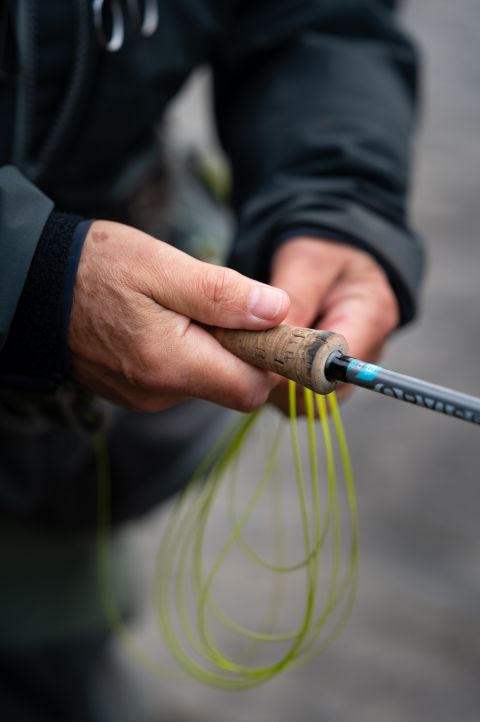
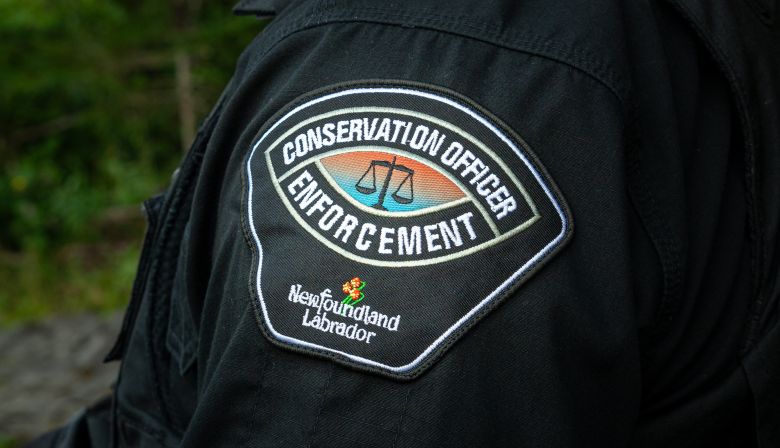
As many seasoned salmon anglers would attest, the interior of their fly boxes is an organized artistry, brimming with feathers sourced from both local and exotic birds and animals. The precision and presentation go beyond the confines of that box—there’s an unspoken understanding that “How you do anything is how you do everything,” especially when engaging with wild Atlantic salmon. Until recently, my experiences echoed this sentiment. However, my latest journey introduced me to an outlier in the salmon fishing community: Paul White. He’s the rotten individual and creative mind behind the unconventional fly, the “Dirty Bomber”—often dubbed the ugliest in one’s collection. If you recall my previous edition of “Rivernotes,” Paul is the guiding force behind the young enthusiasts I mentioned, instilling in them a fervor for salmon fishing.
It was Kim Thompson who bridged the connection between Paul and me. Intrigued by my narrative about the young anglers, Paul was eager to meet. He had recently returned to the island from a fishing expedition in Labrador and was stationed at the River of Ponds campground by the time I arrived. As I entered the cozy camp shop, walls adorned with photographs of triumphant anglers and their catches, I felt an overwhelming sense of history and legacy. Engaging in conversations with the proprietors, I inquired about Lee, absorbing tales of their fathers who once worked for him during the heydays of the lodges.
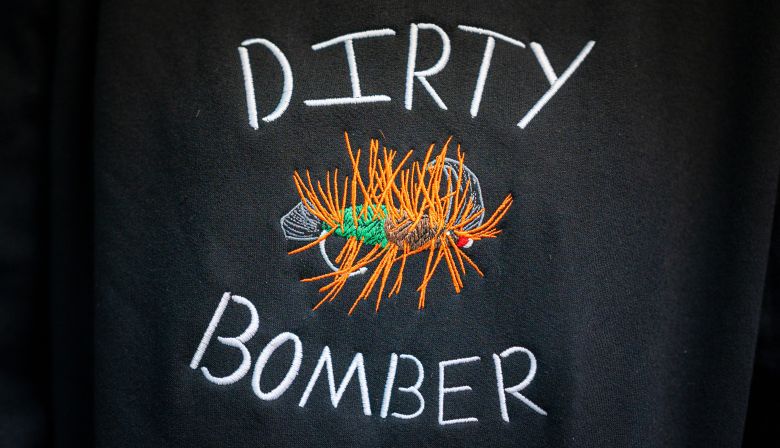
Soon after, Paul and I ventured out to the riverbanks. Confronted by strong winds, we decided on a section nearer to the ocean, sheltered from the wind tunnels formed by trees. Paul was eager to showcase the prowess of the Dirty Bomber. As we settled, he regaled me with the captivating origin story of this unconventional fly:
In the mid-1980s, I stumbled upon the art of fly tying, a passion ignited by Dave Green from Placentia, a colleague of my father at the US Naval Base in Argentia. Dave handed me a Sunrise vice for a mere $5, shared some of his own tools, and recommended supplies from W.W. Doak in Doaktown, New Brunswick. He also lent me a book, the “Universal Fly-Tying Guide” by Dick Stewart, offering his guidance whenever I had questions.
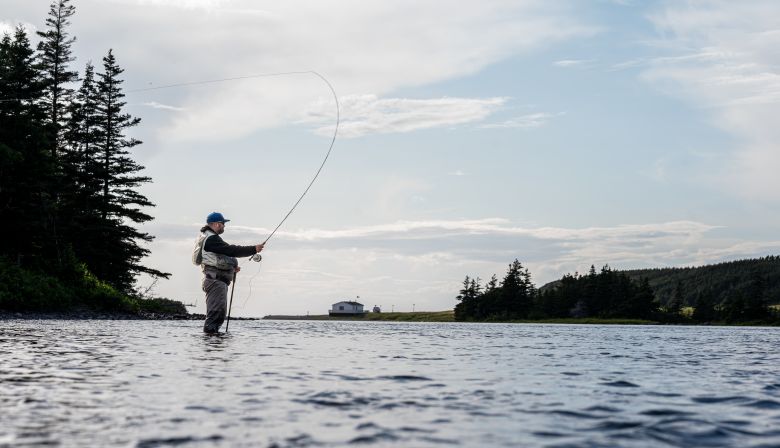
Embarking on this journey, I quickly understood that while humans may craft the flies, it’s the fish that determine their efficacy. The key to successful angling is to focus on the fish’s preferences, not the human’s aesthetic standards. To my surprise, the crude flies I initially dismissed as unsightly turned out to be quite effective in catching salmon.
The lesson I embraced from the start was simple: if something works, don’t meddle with it. This was partly out of necessity – as a kid, I couldn’t afford the “ideal” bomber feather saddles. But over time, it became about innovation and creativity. My first attempts at spinning deer hair for flies resembled feline furballs rather than functional lures.
My early endeavors had me tying deer hair bugs with brown squirrel tails. Later, I attempted a bomber with dual white calf tail wings. Budget constraints meant I couldn’t opt for pricey saddles and dry fly capes. Instead, I used Chinese rooster capes and selected Indian Dry Fly capes, sourced from WW Doak and sports stores in Mount Pearl Square and Corner Brook. While not the ideal Whiting or Metz bomber feathers, these hackles were broader, fluffier, and worked astonishingly well when wrapped around my crafted lures.

Read the full story about the Dirty Bomber, HERE.
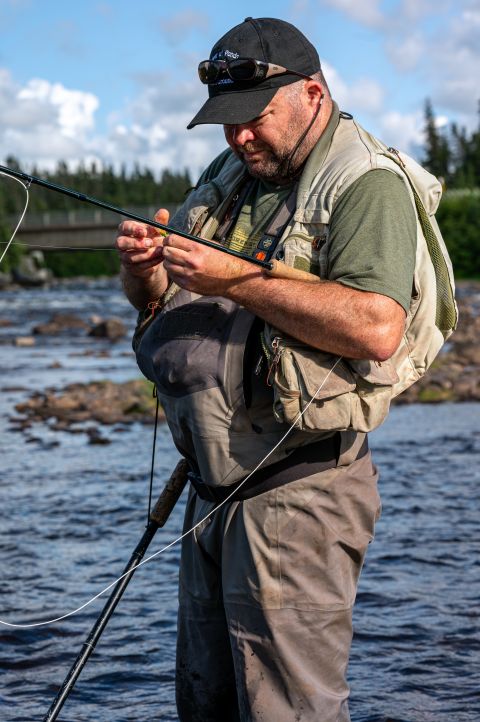
Thank you for being part of the Rivernotes community and tuning in each week as I navigate the stunning, rugged landscapes of salmon country. As always, share the Rivernotes blog with friends who might appreciate these stories. Each share and gift given becomes a ripple that could spark a wave of change.
Please consider contributing to ASF, HERE.
Also, I love hearing from you all, especially those of you who challenge me to do a better job! Please, always feel encouraged to reach out directly to Rivernotes@asf.ca or Pdore@asf.ca with comments, questions or concerns!
Until next week, stay sharp, and tight lines!
Peter


Read the Full Report from Charles Cusson Quebec Program Director, Here
Editor’s Note:
On the eve of my first trip to Gaspe Peninsula’s Bonaventure River, I found myself at the Atlantic Salmon Federation (ASF) headquarters in St. Andrews, New Brunswick. We were there to welcome Andrew Clarke and Kristen Noel, the new members of the ASF Communication team, with a casual post-work barbecue.
As I busied myself with some last-minute adjustments to my truck, preparing for what I anticipated to be a lengthy journey, Bill approached me. “Impressive setup, Peter. Where are you off to?” he asked. With a touch of uncertainty, I revealed the plan I had hatched with Kate and Scotty Sherin, and my fishing pals from Maine, Joe and Orion.
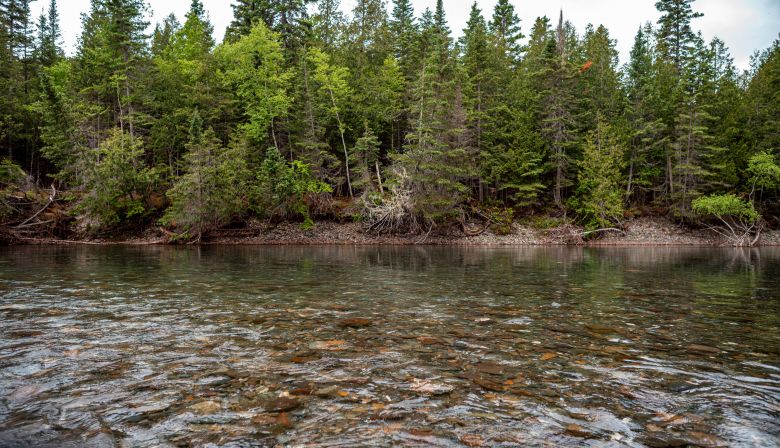
In the midst of our conversation, I voiced my belief that dry fly fishing for trout was the world’s finest type of fishing. Bill retorted, “That’s probably because you haven’t tried dry fly fishing for salmon yet. It’s a completely different experience!”
His curiosity piqued, Bill then asked, “What type of rod are you packing?” I showcased my Orvis 8wt rod and Hydros reel. He responded, flashing his trademark grin, “That might not be enough for what you’re up against.” He continued, “The Bonaventure is full of fish that’ll take you into your backing in a flash. Good luck!” Wrapping up our conversation with his light-hearted jest, he wished me a fun and safe journey.

It was a magical morning on the Bonaventure, characterized by a cool, cloudy atmosphere with a delicate mist gracing the water. I found myself in the company of a close-knit group of ASF friends at Camp Bonaventure. My morning was spent fishing alongside my trusted friend and skilled guide, Robert Benwell.
Departing the camp at 8 am, we navigated our canoe gently upriver, scrutinizing every pool and pocket for resting salmon. Whenever we spotted a few fish, Robert skillfully aligned the canoe to ensure the optimal angle for a lengthy cast and a drag-free drift. We alternated, each casting our Bombers towards the sighted fish. Some salmon instantly attacked our flies on the first cast, while others required several attempts before finally being hooked. There’s an unparalleled thrill in repeatedly coaxing a salmon before it finally bites.

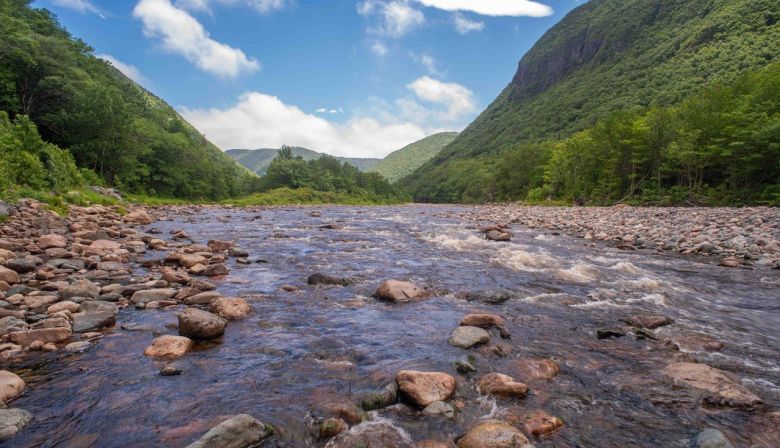
Michael Baytoff, Rivernotes Contributor, Reports:
For decades, I’ve admired pictures and read stories about the enchanting Margaree River and Cape Breton Island. This past July, my long-awaited chance arrived to explore this beloved valley and sacred river. After a lengthy drive from Halifax, I approached the valley just before dusk. An eerie fog enveloped me, deepening the sense of mystery. Navigating the dense fog and impending darkness, I cautiously drove the winding gravel and dirt road to Big Intervale Lodge, perched along the upper reaches of the Margaree. I sought the river’s presence, to be serenaded to sleep by its murmurs and to awaken to its melodies. This place was a dream come true.
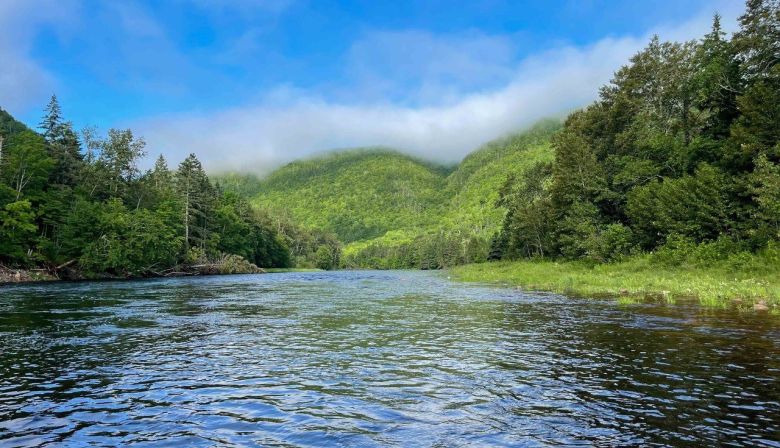
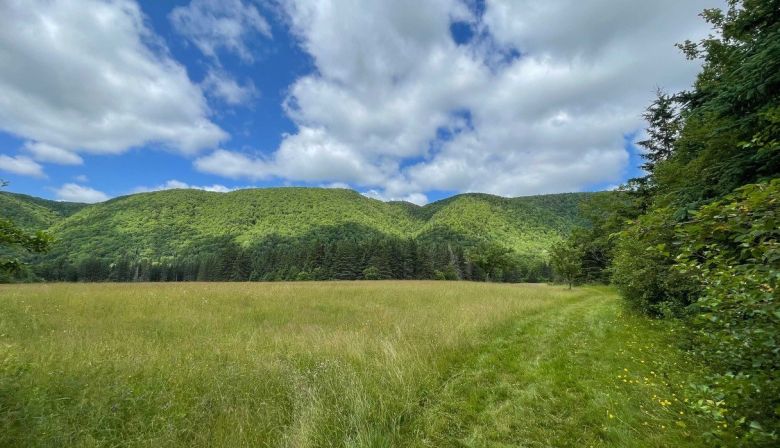
My days were filled with discoveries: famed river pools, warm encounters with locals and fellow travelers, and whispers of Margaree’s tales. A memorable day was spent hiking in Cape Breton Highlands National Park at Cheticamp, reminiscent of Yosemite Valley. A vivid memory is of a vibrant salmon in Cheticamp’s clear rivers, which made a swift exit soon after our encounter. Yet, in Margaree, brook trout were plentiful, with the occasional brown trout making an appearance. Salmon, though present, remained elusive.
After fulfilling days by the river, comforting meals and the warmth of a malt drink ensured restful nights. I yearn to return, to immerse myself once more in this dreamy valley, with its welcoming people, rich history, and enduring serenity.
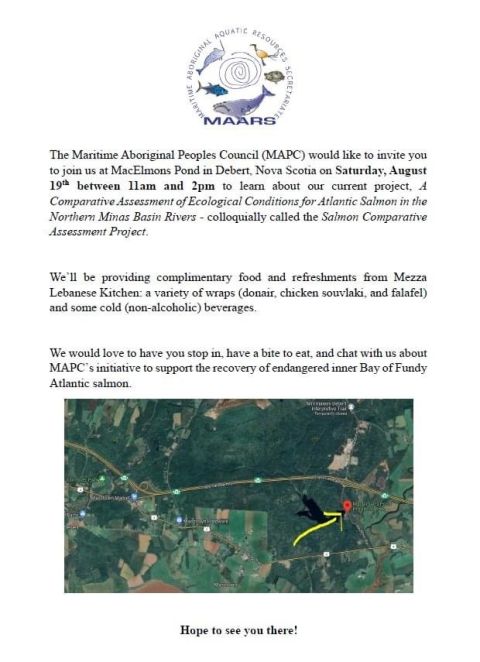

Nathan Wilbur, ASF’s Executive Director of Regional Programs, Reports:
Cooler nights and a blast of rain this week have combined to create fantastic water conditions throughout New Brunswick’s salmon rivers. As a result, warm water protocol closures have lifted on the Nepisiguit and Miramichi, and there are currently no warm water closures in the province. We couldn’t ask for much better conditions in early August.
After a very warm July, fishing has picked up with the improved water conditions in August, and fresh fish have been reported coming into parts of the Miramichi system and Nepisiguit.
Despite great water conditions, there is a crisis happening on the Northwest Miramichi. A protection barrier run by the Miramichi Salmon Association on the Northwest Miramichi is showing alarmingly low returns compared to previous years. Keep in mind, the barrier is located far upriver in the system so only captures a small portion of the run, but enables comparison from year to year.
Just how bad is it? In 2023 as of August 8th, only 5 grilse have showed up to the Northwest Miramichi barrier. Compared to a good year in recent history, this is a 99% reduction to the same date in 2011 when 547 grilse had showed up. Compared to a recent poor year, this is a 96% reduction from the 115 grilse that showed up to the barrier by early August in 2019.

Collectively, ASF and partners including the New Brunswick Salmon Council, the Miramichi Salmon Association, the Miramichi Watershed Management Committee, and Indigenous organizations have been raising the alarm bells with DFO for some time based on the dismal smolt tracking results and striped bass predation. We are asking DFO to urgently reduce the striped bass population in such a way that is remains a sustainable population but improves balance in the ecosystem, not only with salmon but other important species like smelt and alewives. We have proposed a number of practical measures that DFO Fisheries Management could implement immediately, such as allowing anglers to keep any sized striped bass in freshwater, removing the upper size slot limit, and helping Eel Ground First Nation achieve their commercial quota of striped bass.
DFO recently published their Gulf Region Atlantic salmon and striped bass science reports showing returns from 2022. Of note, the striped bass spawners had increased from approximately 300,000 over the past few years to 471,800 last year.
Salmon : Science Response 2023/035 (dfo-mpo.gc.ca)
Striped bass : Science Response 2023/004 (dfo-mpo.gc.ca)
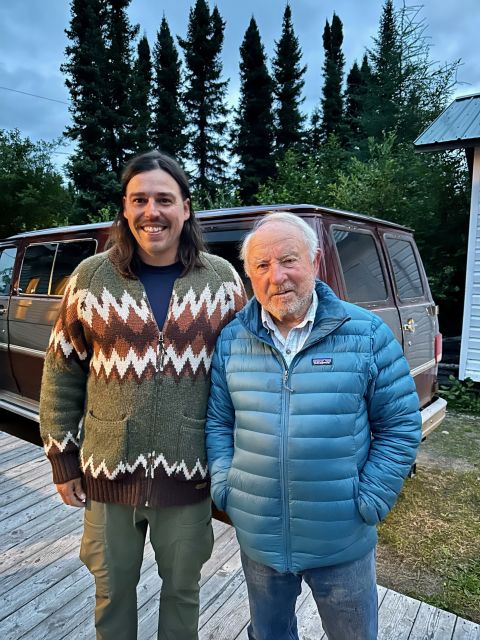
Over on the Island of Newfoundland:
The Northern Peninsula has seen improved water conditions, but fish remain elusive, making fishing activities languid.
In Western NL, Dan Chaisson’s recent venture to Harry’s River was uneventful, spotting just one fish. Rivers in Bay St. George, now accessible all day, aren’t teeming with fish, especially in the lower sections. Eddie Donnelly and Brayden Coish had similar subdued experiences on the Humber River, pointing to fewer fish and warmer water temperatures.
Central NL is slightly more optimistic. The Gander River, now welcoming anglers throughout the day, has seen satisfactory catches. Dave Vardy, in particular, had a rewarding day, releasing two sizable fish. However, the Exploits River is less bustling, opening only in the early mornings due to warmth, and the catch reports are subdued.
On the South Coast, rivers are accessible all day, but water levels are wanting. Melvin Banfield’s observations on the Baie de L’eau River are concerning. He believes a new fishway, overseen by the aquaculture firm Greig, might be hindering fish movements, as the current population is noticeably less than previous years.
Lastly, the Avalon Peninsula narrates a similar story of low water levels and dwindling catches. However, Mitch Randell’s recent escapade on the Renews River was fruitful, where he caught and released his daily quota.
In sum, while some areas hint at promise, the general mood across the regions leans towards a quieter fishing season.
Jason Valliere, Maine Department of Marine Resources Scientist, Reports:
Looks like summer is over. River temperatures have dropped 5-6 degrees C ,9-10 degrees F.
Observing juvenile river herring migrating down river headed toward the sea has been a frequent occurrence at the fish way in the past couple weeks.
23 salmon were captured at Milford since the last report. That brings the estimate to 1519. This number has not been adjusted for “in season” recaptured fish so it will change. In season recaptures are Fish that have already passed through the fishway once and have decided to drop downstream and come back up through the lift again….
Milford is currently shut down for a few days for annual summer maintenance.
Next report will be in 2 weeks….